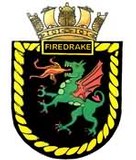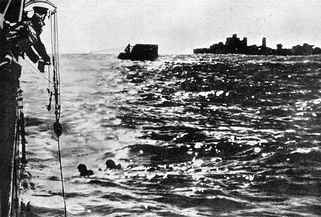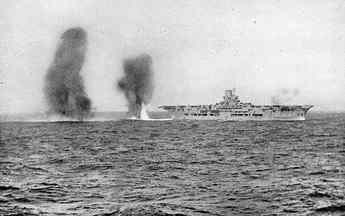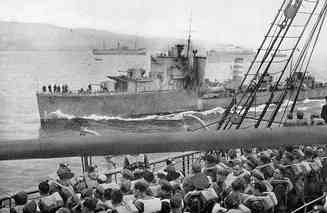 HMS Firedrake |
|
MOD
Summary of Service 1935 - 1942.
|
| HMS Firedrake, an 'F' class Destroyer, was ordered under the 1932 program on the 17th March 1933. It was built on the Tyne, by Vickers Armstrong, using Parson machinery. Laid down on the 5th July 1933, the HMS Firedrake was launched on 28th June 1934, by Mrs Blake, wife of Rear Admiral Geoffrey Blake DSO, the Fourth Sea Lord. She was completed on 30th May 1935 at a cost of £243,916 - the eighth of the class completed. On commissioning, the Firedrake joined her sisters in the 6th Destroyer Flotilla, Home Fleet. |
 |
In May 1939, Home Fleet Destroyer flotillas were reorganised and the 'F' class became the 8th DF. At the outbreak of the Second World War on 3rd September 1939, the 8th DF was based with the rest of the Home Fleet, at Scapa Flow in the Orkneys. On 11th September, the Firedrake left Scapa with aircraft carrier
HMS Ark Royal for an anti-U-boat sweep to the westward of the Orkneys. |
| At 15.34 hrs, HMS Foxhound obtained ASDIC contact and attacked with
depth charges, followed shortly by the HMS Faulknor and the HMS Firedrake.
The U-boat was forced to the surface, surrendered and sank in position
58° 32’ N, 11° 49’ W. The entire crew of 43 officers and
men, were taken prisoner. On the 22nd September the Firedrake, together with HM ships Fortune, Mashona and Matabele, dropped 24 depth charges on a U-boat contact in position 58° 27 N, 01° 30 W, with no result. The following day in company with HMS Fortune, the Firedrake attacked another contact 40° NNE of Peterhead again with no result. On the 25th September practically the whole of the Home Fleet was ordered to sea to cover the return to Rosyth of the submarine HMS Spearfish which had been badly damaged on patrol in the Heligoland Bight. The Firedrake, together with HM ships Fame, Foresight, Bedouin and Punjabi accompanied the Nelson, Rodney and Ark Royal: the rest of the 8th DF escorted the Battle Cruiser Force and the 18th Cruiser Squadron. The Spearfish was met by the destroyers Somali and Eskimo early in the morning of the 26th September, whereupon all ships made for home. During the return passage the fleet was repeatedly attacked by enemy aircraft; the Ark Royal was near missed and the Hood received a glancing blow on her armour belt, but all ships returned safely to their bases on the 27th September. |
|
On the 4th October 1939, 25 miles east of the Orkneys, the Firedrake picked up six survivors from the SS Glen Farg , torpedoed and sunk by a U-boat at 05.50hr that morning, and landed them at Scapa. The following day she attacked another contact in position 59° 55 W, but again there was insufficient evidence for a kill. The Firedrake spent the rest of 1939 on patrol duties with units of the Home Fleet, broken by a defects period on the Clyde during November. On the evening of the 12th March 1940 the Firedrake unsuccessfully attacked a U-boat contact in position 58° 49 N, 02° 20 W. Later in the month she took part in operation DU - a sweep down the Norwegian coast and into the Skagerrak to intercept enemy shipping outside territorial waters. |
| On
20th March, the Firedrake was one of eight destroyers which left Scapa
at 23.30hr accompanying the 2nd Cruiser Squadron HM ships Galatea
(flag of VA 2CS), Aurora, Arethusa and Penelope. On the evening of the 21st March the ships divided into two equal forces - force B consisting of the Galatea and Aurora, with the destroyers Firedrake, Foxhound, Sikh and Somali and force C, consisting of the remaining two cruisers with the destroyers Fame, Foresight, Mashona and Matabele. Force B cruised off the southern coast of Norway between Lister and Osko lights. A number of Danish vessels were investigated but the only two German ships were well inside territorial waters. |
 |
| The force rejoined at 07.00hr on 22nd March and throughout the day the whole group proceeded northwards along the Norwegian coast. At 09.22 HMS Somali reported a German vessel ahead which proved to be the SS Butt. |
|
A warning
shot was fired to stop her, but she managed to escape into territorial
waters. All other ships encountered during the forenoon were neutrals.
At noon the force was off Utsire light when course was altered to
263° to simulate a return to base, but at 14.00hr when out of sight
of land, it worked round to the south, altering to 090° at 18.00hr.
An hour later force C was detached; each force then swept midway
between the Norwegian and Danish coasts, covering the normal approach
routes, but two neutral vessels were all that were sighted. At 11.43hr
on the 23rd March the Aurora and the destroyers were detached to
Scapa, and the other ships proceeded to Rosyth. |
 |
In
June she was detailed, with HM ships Coventry, Southampton, Havelock,
Fame, Beagle, Delight and Echo, to rendezvous with and escort a
convoy of eight merchant ships between Harstad and the Clyde. On
12th June she was again attacked by enemy aircraft and was narrowly
missed by a bomb which fell some 20 ft away, causing minor splinter
damage above and below the waterline amidships. The port steering
motor A 4.7in gun were put out of action, and the Firedrake proceeded
to the Clyde for action damage repairs, completing on the 20th June. |
|
During
July 1940 the Firedrake escorted convoys between the UK and Iceland.
On the 2nd July she was one of a large number of ships detailed
to assist in the search for survivors from the SS Arandora Star,
which with German and Italian internees and prisoners of war aboard,
had been sunk 125 miles from Malin Head. |
| At the
end of August the Firedrake was one of a number of ships which participated
in operation Hats passage of naval reinforcements to the Eastern
Mediterranean. She left on the 22nd August with destroyers Bedouin,
Mashona and Tartar, escorting HM ships Illustrious, Sheffield and
York to Gibraltar, arriving on the 29th August. The capital ships continued on to Alexandria, escorted by Mediterranean Fleet destroyers, but the Firedrake remained at Gibraltar. On the morning of 17th September, together with HM Gallant, she left Gibraltar to join Force H, consisting of the battle cruiser HMS Renown and four destroyers, then patrolling off Casablanca to intercept any Vichy French warships, returning to Gibraltar on 20th September. At the end of September force H left Gibraltar to intercept the French battleship Richelieu should she attempt to leave Dakar for a Biscay port. |